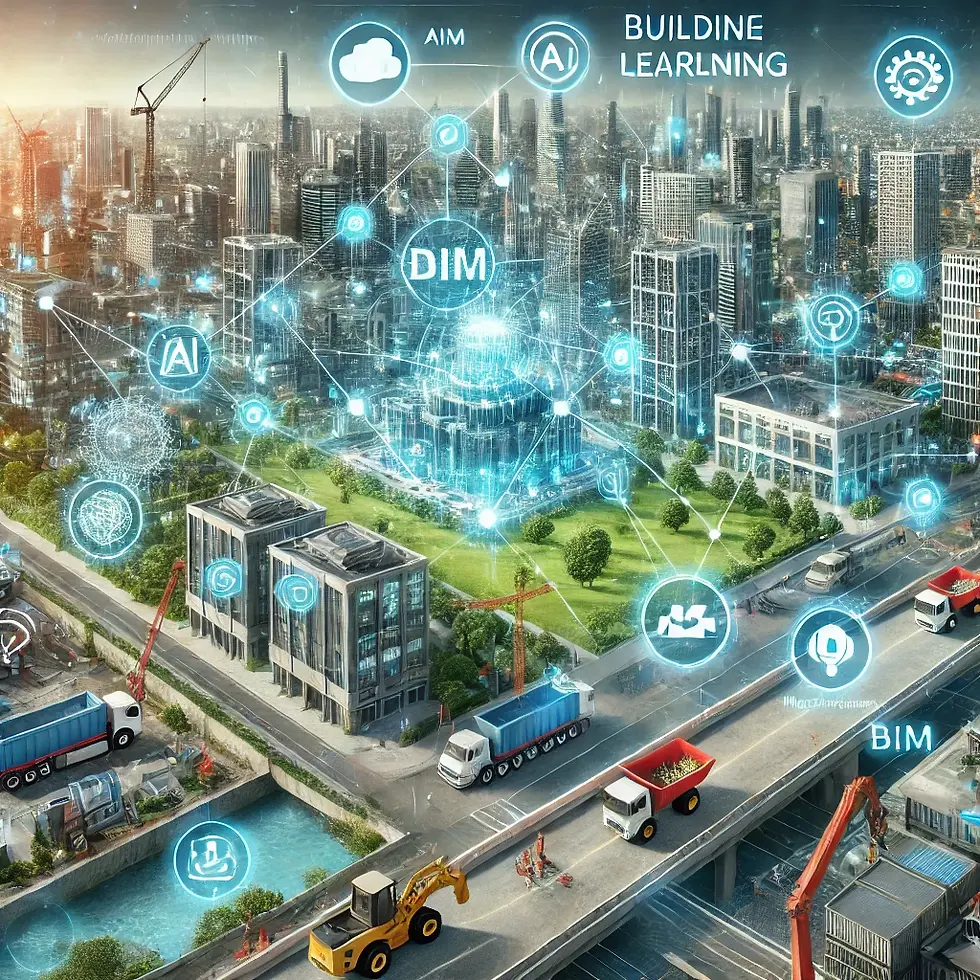Machine Learning and BIM: The Future of Smarter Construction
- Mzukisi Qunta
- Oct 14, 2024
- 4 min read
As the construction industry continues to evolve, the integration of Building Information Modeling (BIM) with Machine Learning (ML) is driving innovation in the design, management, and construction of smart cities. This collaboration is transforming construction projects by improving efficiency, cost-effectiveness, and sustainability. For developing countries like South Africa, where urban planning and resource management face unique challenges, this combination is poised to deliver solutions to critical issues like housing shortages and resource allocation.

What is Machine Learning in the Context of BIM?
Machine learning is a type of artificial intelligence that enables systems to learn from data, identifying patterns and making decisions with minimal human input. When applied to BIM, ML allows construction teams to analyze large datasets, predict potential risks, and automate complex processes like design optimization, clash detection, and facility management.
Machine learning offers potential applications such as:
Predictive analytics for maintenance and repair.
Generative design solutions that optimize layouts and sustainability factors.
Automation of clash detection in BIM models to reduce costly errors during construction.
Challenges of Integrating Machine Learning in BIM
While ML can transform the construction industry, it comes with challenges:
Data Quality and Volume: Machine learning models require high-quality data, but the fragmentation and inconsistency of data across BIM platforms limit ML's effectiveness.
Interoperability: BIM platforms like Revit, Navisworks, and ArchiCAD must seamlessly communicate to make machine learning systems effective, a challenge in multi-stakeholder projects.
Skilled Workforce: There's a skills gap in the industry for professionals well-versed in both BIM and ML, requiring more targeted education and training.
Cost: The high cost of implementing ML in smaller construction firms is a barrier to widespread adoption.
Case Studies: Real-World Applications of Machine Learning in BIM
Several projects have successfully integrated ML with BIM:
1. Google’s Headquarters in Mountain View
Using BIM and machine learning, Google's headquarters design relied on ML algorithms to optimize the building's natural light, energy usage, and operational efficiency. The ML model generated multiple design options, providing architects with data-driven solutions that met sustainability goals (Autodesk, 2022).
2. UK Smart City Initiatives
Several smart city initiatives in the UK use BIM combined with machine learning to manage urban infrastructure. These projects demonstrate how machine learning can predict traffic patterns, manage energy usage, and optimize urban layouts for both functionality and sustainability.
3. Qatar National Library
Machine learning and BIM systems monitor MEP (Mechanical, Electrical, Plumbing) components of the library. Predictive models forecast when repairs are needed, avoiding sudden breakdowns and reducing operational costs through predictive maintenance (Jain, 2023).
Cape Town Housing Crisis: How BIM and Machine Learning Can Help
In Cape Town, the housing crisis continues to affect thousands of residents due to rapid urbanization and resource constraints. By integrating BIM and machine learning, the city can streamline construction processes, reduce housing development costs, and make data-driven decisions that optimize land use and building layouts.
Benefits for Cape Town:
Optimizing Designs for Affordable Housing: Machine learning can analyze site data, proposing housing layouts that maximize space and minimize material usage, crucial in developing large-scale housing projects.
Predictive Maintenance in Informal Settlements: For informal settlements and low-income housing, machine learning-driven predictive maintenance can help maintain infrastructure such as water and sanitation systems.
Water Crisis Management: Machine learning models integrated with BIM can simulate water usage, predicting shortages and optimizing rainwater harvesting systems in Cape Town’s drought-prone regions (GreenCape, 2023).
The Future of Machine Learning in BIM
As construction projects grow in complexity, machine learning in BIM will continue to evolve:
More Predictive Analytics: Future advancements in ML could improve predictive models, forecasting everything from weather conditions to resource shortages during construction.
Sustainability: Machine learning can help architects and engineers design more energy-efficient buildings by analyzing real-time data and simulating various environmental conditions.
AI-Powered Project Management: Tools like AI project managers could become a reality, automating much of the decision-making during construction to enhance productivity and reduce human error.
In regions like war-torn countries and developing nations, these advancements will have far-reaching impacts. In places struggling with urban destruction or lacking infrastructure, BIM and machine learning could streamline reconstruction efforts and optimize resource allocation for rebuilding homes, schools, and hospitals.
How to Get Started with Machine Learning in BIM
For professionals seeking to incorporate machine learning into their BIM workflows, several educational resources are available:
Coursera: Offers various courses on AI and machine learning in the context of architecture and construction.
Udemy: Provides comprehensive courses on BIM automation and AI in construction.
Autodesk University: Includes tutorials on integrating AI tools like Project Refinery with BIM software like Revit for generative design.
Conclusion
Machine learning and BIM are revolutionizing the construction industry, creating smarter, more efficient, and sustainable cities. This technological integration is especially important for regions like Cape Town, where housing shortages and water crises present ongoing challenges. By leveraging the power of AI and BIM, we can create innovative solutions that address these crises and lay the foundation for more resilient, data-driven urban infrastructure.
With continued innovation, the future of machine learning in BIM holds the potential to reshape not only how we construct buildings but how we sustain and optimize entire cities.
References
Autodesk. (2022). Generative Design in Architecture: A Case Study of Google's Headquarters. Autodesk University.GreenCape. (2023).
Water Crisis in Cape Town: Addressing Urban Water Shortages with BIM and Machine Learning. GreenCape News.Jain, R. (2023).
Qatar National Library and Predictive Maintenance with BIM. Smart Construction Journal.Smith, D. (2023).
The Benefits of Using BIM. BIM LCA. Retrieved from https://bimlca.eu/the-benefits-of-using-bim/




Comments